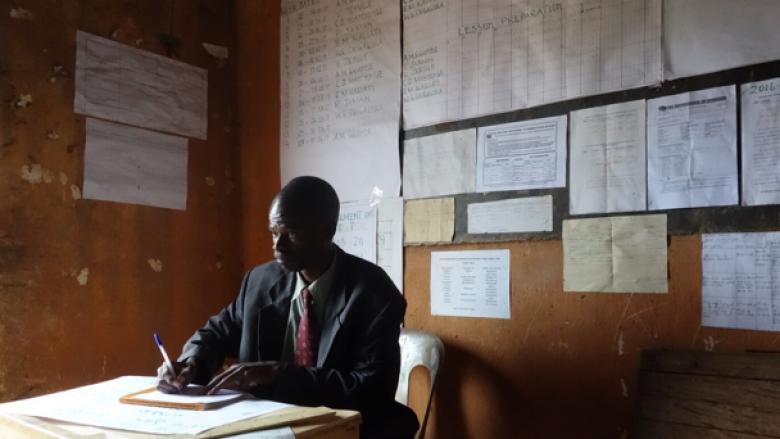Policymakers in low- and middle-income countries who are working to improve student learning often find themselves flying blind. They see the budget that goes into education and (sometimes) the learning that students come out with, but they lack information on the crucial factors in between—the practices, policies, and politics—that drive those learning outcomes. The new Global Education Policy Dashboard initiative will fill that gap.
THE CHALLENGE: UNDERSTANDING WHAT DRIVES THE LEARNING CRISIS
Many countries, despite having significantly increased access to education for their children and youth, now realize that they are facing a learning crisis. For instance, when grade 3 students in Nicaragua were tested in 2011, only half correctly solved 5 plus 6. And in Kenya, Tanzania, and Uganda, when grade 3 students were asked recently to read a sentence such as “The name of the dog is Puppy,” three-quarters could not answer what the dog’s name was. Examples like these from around the world underline that schooling is not the same as learning—even though education policy often assumes that it is.
The World Development Report 2018 argued that the learning crisis has multiple causes: poor service delivery in schools and communities, unhealthy politics and low bureaucratic capacity, and policies that are not aligned toward learning for all. To tackle the crisis and improve student learning for all, countries need to know where they stand on these three key dimensions—service delivery, policies, and politics.
But providing such a systemwide overview requires better measurement. Many of these drivers of learning are not captured by existing administrative systems. And although new measurement tools capture some of those aspects well, no single instrument pulls together data on all these areas. This gap leaves policymakers in the dark about what is working and what isn’t.
OUR RESPONSE: SHINING A LIGHT ON THE DRIVERS OF LEARNING
To fill this gap, the World Bank, with support from the Bill and Melinda Gates Foundation and the UK’s Department for International Development, is designing a Global Education Policy Dashboard, which will measure the drivers of learning outcomes in basic education around the world. In doing so, it will highlight gaps between current practice and what the evidence suggests would be most effective in promoting learning, and it will give governments a way to set priorities and track progress as they work to close those gaps. This collaboration will advance the goals of the Human Capital Project, a global effort to accelerate more and better investments in people for greater equity and economic growth.
The dashboard will start by focusing attention on early-grade learning and school participation. The next set of indicators will measure the quality of service delivery, focusing on the four key school-level ingredients of student learning: teaching, school management, inputs and infrastructure, and learner preparation.
In addition, the dashboard will measure deeper systemic drivers: the policies and politics that determine the quality of service delivery. The end goal is to have a set of indicators that is comprehensive but also focused so stakeholders can pay attention to what is really most important.
The dashboard will be piloted in 13 countries in 2019, with a goal of rapidly expanding coverage after lessons from the pilots have been incorporated.
OUR APPROACH: HOW THE DASHBOARD WILL ACHIEVE THIS
Develop tools to collect data at all levels of the system on a regular basis. Because of the shortcomings of existing data on the drivers of learning, the dashboard will rely primarily on data collected under this initiative, rather than just presenting existing data in a new framework. In each participating country, the initiative will deploy various new data-collection instruments, including a School Survey, an Expert Survey, and a Bureaucracy Survey. This multilevel approach is necessary to gather data on all the drivers of learning, from the level of the learner to the level of the system. The aim is to develop lean and cost-effective instruments, so the dashboard can be inexpensive enough to be applied repeatedly and to be scaled up after the pilots.
Embed innovative measurement approaches in a coherent, system-wide framework. The dashboard approach combines the conceptual framework of the World Development Report 2018 with indicators derived from streamlined versions of the most current measurement tools. These tools include the Service Delivery Indicators (SDI) initiative, the Systems Approach for Better Results (SABER), the Measuring Early Learning and Quality Outcomes (MELQO) project, the World Management Survey, the Bureaucracy Lab surveys, and others.
Present a user-friendly dashboard interface. After gathering data, the dashboard initiative will display the indicators in an easy-to-use interface, focusing attention on key constraints. The primary audience will be policymakers, placing a premium on a visual representation that illuminates key relationships and constraints on learning.
Make resources available for implementation in all developing countries. Along with developing the dashboard and testing its usefulness through the pilots, the World Bank and partners will create tools and resources to make it easy for countries to report their data in the dashboard themselves. Ultimately, this will allow global scale-up to all developing countries that find it useful.

